RomanCulture
Neha Patel and Katie Pachkovsky
Table of Contents
-Education
-Language
-Fashion
-Literature
-Social Classes
-Religon
-Food
-Housing
-Theater
-Technology
-Arts and Architecture
INTRODUCTION
The unique daily life of Ancient Rome was advanced compared to many other civilizations of that time period. Although Roman culture was adopted and influenced mostly from the Greeks, Romans modified these practices, ultimately developing their own lifestyle. Their life is interesting as well as useful to our modern day world as they have made significant contributions to society of today.
Education
Ancient Roman education was very different than how education is structured today. At first, there was no public education and most parents were responsible for teaching their children necessary facts and lessons about life. Some wealthy families had the advantage of being able to afford slaves to teach their children. These private tutors were known as pedagogi and would sometimes carry books home for the children. Later, approximately around the sixth century B.C., education was improved so public education was available. Formal schooling replaced homeschooling as public schools were established all around the Roman Empire. Before the sixth century, methods included holding kids down by the head and beating them until they came up with the correct answer, which proves that the teachers held the decision of how severe punishments could be. In the latter educational period, there were limitations on the severity and cruelty of student punishments. Boys were usually trained in agriculture and domestic areas, but the majority of emphasis was placed on warfare. Until they age of seven, girls and boys grew up together under the care of their parents. At the age of 12, middle class children were sent to secondary school and some continued on at the age of sixteen to attend a rhetoric school taught by a rhetor for law students. Rich boys were privileged and had the opportunity of being sent to a private school called a ludus, where basic arthmetic, writing, reading, Latin, and Greek was taught. The teacher was known as the ludi magister or magistra. For more information on Roman Education, click here.
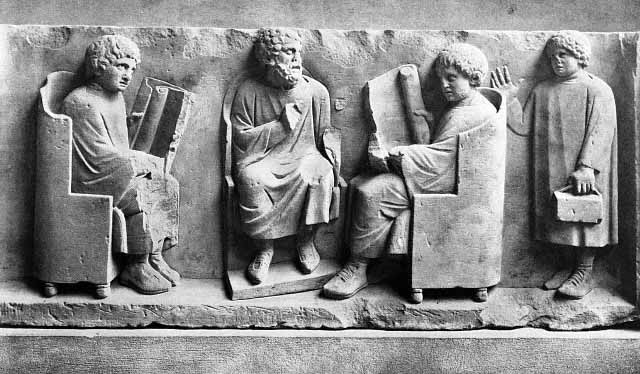
An artist's depiction of a typical Roman school setting
Still, even after all of these improvements in education, the majority of kids were home-schooled because parents had to pay for their children's education and some couldn't afford it. Science, technology, and math was not emphasized in school because it was believed that Roman children needed to learn literacy, knowledge, and oration to survive; not bread-oriented but rather life-oriented subjects. Literature like the Iliad and Odyssey were not common in public schools until much later, when the abacus and wooden tablet (tabulae), written on with a stick called stilus, were used to take notes and do sample problems. Ink and papyrus, taken from the Egyptians, was used as well. Children sat on benches or stools and had no desk or blackboard. Girls were still not equally educated as boys were, although for the most part they did go to school to learn household chores. Rather than being prepared for war like the boys, they were taught how to become a housewife by learning how to take care of children, sew, cook, weave, etc. Wealthy families would teach their girls how to manage numerous household slaves as well. The Roman system of education was effective in providing the basis for our modern day schooling.
LANGUAGE:LATIN
As Rome began to gain power, the language of Latin spread quickly throughout the region into the Mediterranean and European area. Two types of Latin emerged: Classical Latin used in poems and writing, and Vulgar Latin used in everyday speech by ordinary people. Its precise form and dialect made it very popular with Romans. Its earliest known records are shown to be in the sixth century B.C. and it branched off into the many Romance languages around the ninth century B.C. Romance languages which originated from Latin are now spoken all over the world today and include English, Spanish, French, Italian, Portuguese, etc. Although Latin isn't orally spoken today, it is still practiced by many people while being written, read, and studied by students all over the world. By studying this language, they are able to increase their own knowledge about how the use of different languages originated many years ago.
FASHION
Roman clothing and fashion during its ancient years owes much credit to Ancient Greece. Undergarments were loin clothes knotted to one side made out of simple linen to assure comfort and flexibility. The tunica was the basic garment for Romans and slaves in Rome, worn by both sexes, although women generally had a longer tunica with long sleeves attached. A toga was worn by men, specifically Roman citizens, and could be worn on top of a tunica. The toga was a blanket made of wool that was worn as a dress with one arm free. Its elegance and grace in physical appearance stole from its comfort and made it difficult to sit or stand for Romans. In some cases togas were worn to show social class; for example senators wore a toga praetexta with a purple border while ordinary men wore white togas. Young boys who hadn't yet reached the citizen age also wore a toga called a toga praetexta, even though it didn't symbolize class. When they became old enough (about 16 years of age), they wore the citizen's toga called the toga virilis. On top of the toga, women wore the stola, which reached all the way to the ground and sometimes had a decorative border to display wealth and high social class. Silk clothing and dyes were common for the wealthy to use on their clothing; it helped them stand out from the ordinary citizens.
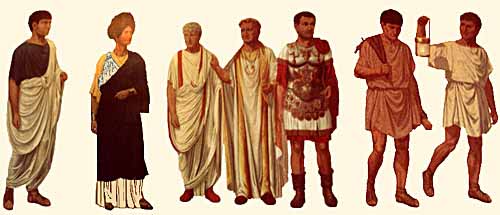
Roman citizens dressed in traditional garb
They wanted to display their wealth in a manner that would be obvious by taking one glimpse at their clothing. All children wore a necklace given to them at birth, known as a bulla, which was believed to be an amulet that would ward off evil spirits. Girls took this bulla off on their wedding day and boys removed it when they became a citizen of Rome. Calceus, the most common type of Roman footwear, was worn as well as sandals for comfort. Cloaks were popular when weather was extremely raw. During the third century B.C., Greek barbers moved to Rome to spread their fashion statement of clean-shaved faces. Slowly, Roman men started to get rid of their stubble as hair also grew shorter. Of course, women wore more elaborate and extravagant Etruscan hairstyles by using ribbons or pins to decorate it. Curly ringlets were also popular. Makeup, powder, mascara, and jewelry were popular as women collected necklaces, bracelets, and rings to show off to their friends. Soldiers wore chain mail armor with leather protection on the inside to avoid injuries. Roman fashion during this time was fascinating and very different from today's clothing. More Ancient Roman Fashion can be studied here.
LITERATURE
Ancient Roman literature, although not extremely notable, was advanced as it branched off of Greek literature. All Roman writing has not been saved, but what is left of it is very detailed and precise. The Iliad and The Odyssey written by Homer, a Greek writer, was translated into Latin and heavily influenced Roman education in literature during this time period. It was the focus of most literature classes, along with other Greek writings by Aeschylus, Sophocles, and Euripides. The Silver Age of Roman Literature was an era during the rule of Nero which finally proved that Romans could excel in literature without the help of their Greek neighbors. Writers such as Cicero, Publius, and Ovid emerged during this time and produced great works. Latin prose under Cato the Elder and satire by Lucilius was significant as well. The Golden Age of Literature (also known as the Augustan Age), brought the increasing popularity of epic poems and Roman theatre plays. Epics were widely written by the Romans and are defined as long, narrative poems about heroic figures and usually include tragedy. At first, Roman epics concentrated mostly on military aspects of the empire and not as much social, economical, or religious elements. Later, a greater number of tragedies, comedies, and histories were written and proved themselves to be the best of their time. Vergil, the author of the Aeneid, and Horace are considered two of the greatest Roman poets today. Although Greek influence was very significant within Roman literature, writing became more extravagant as the Romans adapted it in the following years.


Artist's renderings of scenes from both The Iliad and The Odyssey
SOCIALCLASSES
Roman society was structured as a hierarchy, similar to a pyramid where the minority of Romans were the highest class and the majority had little or no rights. Free Roman citizens were at the top of the social pyramid and were grouped by ancestry and wealth. Right from the beginning, they had more rights such as the right to vote, own slaves, own a business, be protected by the law against unjust treatment, etc. An exclusive right owned by only Roman male citizens was to have three names, like Lucius Caecilius Iucundus, while slaves only had one name, like Grumio. If a Roman was born into a wealthy or prominent family, they became wealthy or prominent themselves later in life. Patricians were Roman citizens who could trace their ancestry back until the rule of Romulus, and plebeians were all other citizens directly beneath them. Patricians mainly were involved in government and rulings while plebeians were the average citizens. Later, plebeians won the right to stand in the Senate by revolting against. Political officials, business men, agrarian workers, and non-property owning individuals were on the social pyramid from highest to lowest, respectively. Women and foreigners came next, followed by freedmen or liberti (slaves who were freed by their masters), and lastly slaves (servi) themselves.

A visual depiction of social divisions within Roman Society
Freedmen were promised citizenship for their children, although they themselves were only promised full freedom, which allowed them to own a business or start their own trade. Many went on to gain the respect of a patrician. Slaves were usually prisoners of war or recent debtors who worked either around the home or on the field. Vernae were slaves born in the household and alumni were acquired as babies. Slaves were not granted any rights until later in the Roman Empire. Their masters made their decisions and the slaves were completely obedient to them as well. However, slavery was a natural part of Roman culture and attempts at abolishment were rare. This was because although slaves were considered property, slaves were not much different from their masters. They lived in the same house, ate the same food, wore clothes which did not show their status, and had a good relationship with their family. Punishment and severity was not common because masters knew the importance of their slaves, and one master could own up to a hundred slaves! Some slaves bought their freedom and others would be awarded it by their masters in their will or during their lifetime. Unlike some other ancient cultures, Rome allowed for social mobility within society.
RELIGION
Roman religion and mythology was heavily influenced, again, by the Greeks and the Etruscans. Strong beliefs in superstition and omens developed as Romans began to fuse their own culture with that of the Greeks. Religious facts on Romans can be found at this link.
The Temple: Many temples were constructed out of marble or stone to honor gods like Jupiter or Mars and visits to the temple were very common, especially when people were about to take off on a dangerous journey or requested a favor.
Religious or Cultural Practices: Sacrifices were presented to the gods on a regular basis, usually food, wine, gifts, or an animal, to ask for favorable deed from the gods. . Household gods and spirits of the home were known as lares and penates, who were also given sacrifices as for thanks for good fortune.
Festivals or Holidays: Lupercalia was a festival celebrated in February to cleanse the town and purify all the spirits that may be present. Saturnalia in December was to celebrate the end of the harvesting season and respect the god, Saturn. People usually had extravagant feasts and dances while exchanging presents and performing sacrifices. Days such as Vestalia, Nemoralia, and Ludi Apolloninares honored gods like Vesta, Diana, and Apollo.
Superstition: Omens (omina) were seen by the people as warnings from the Gods. Nightmares were usually interpreted as a sign that something evil was on its way. Unusual or strange circumstances like a lion wandering on the city streets but not attacking anyone, a burning hand that remained unscorched, or a bird crashing into a closed window were all believed to indicate an ominous future. Similar to our Friday the 13th, the Ides of March (March 15th) was thought to be an unlucky day and people refrained from going outside. It was seen as lucky to cross a threshold with the right foot or wear amulets to ward off evil. Defixiones were curse tablets that people wrote on to call on the gods to punish their enemies, which demonstrates that religion was used for negative purposes as well.
Mythology: Taken from the Greeks, mythology was a huge part of Roman culture. Many famous myths and stories of gods were taught in schools or at home by parents.
Astrology/Divination: Haruspex, meaning a soothsayer, used a corpse's liver to determine how its life would be in the afterlife. Augures was an additional type of divinity that used bird's flight to read the future. Astrology and horoscopes were the study of the stars at someone's birth to predict the future, but it was discouraged in many Roman families.
Life After Death: Romans believed that dead bodies should be treated with respect; otherwise they would come and punish you while you still lived. A tomb and inscription was necessary and many times personal items such as jewelry or a photo was placed inside the decorated tomb for the afterlife in the Elysian Fields.

Roman Gods and Goddesses
Famous Gods/Goddesses:
Jupiter: god of gods
Apollo: god of music and the sun
Ceres: goddess of agriculture
Juno: queen of gods
Mars: god of war
Vesta: goddess of fire and hearth
Venus: goddess of love and beauty
Minerva: goddess of wisdom and knowledge
FOOD
The Romans enjoyed an abundance of food, preparing three meals a day. The morning meal or ientaculum was relatively simple, consisting of fruit and bread. While the midday meal, prardium, featured cold meat, fish, vegetables, and bread. Supper or cena, was the most elaborate of their meal times potentially lasting numerous hours due to the quantity of food consumed. Reclining on an arrangement of couches centered around the square dining table, Roman citizens perceived this three course meal time as a relaxing affair. A form of appetizer referred to as the gustatio was served first, containing dishes of eggs, fish, vegetables, domice, oysters, and snails. The main course, primae mensae, boasted roast or boiled meats and poultry. Exotic elements were occasionally incorporated such as ostrich, but all were favored with herbs such as coriander, oregano, mint, thyme, fennel and sage. The overuse of spices such as pepper, nutmeg, and ginger were convenient in masking the taste of spoiled foods, or the metallic taste of pots, which in some cases were made of lead. Cena concluded with secundae mensae the designated time for deserts and fruits. Such an elaborate feast would not have been enjoyed by all Romans, with poorer individuals partaking in a simpler version of these meal times, usually lacking meat or fish. Instead bread, vegetable stews, and porridge accounted for most of their caloric intakes. More information on the Roman diet can be found here.

Diners lounging as they enjoy their lavish meal
HOUSING
The housing complexes available to Roman citizens varied greatly depending on one’s financial standing. Middle class citizens occupied blocks of apartments called insulae or “little islands”. While usually two to three stories, those constructed in Rome, were considerabley larger, boasting five to six levels to accommodate the population of one hundred million individuals as of 100 A. D. Poorer citizens were allotted the rooms located on the upper levels, as their size decreased with height. The overall amenities for these structures were generic, containing the bare essentials of shelter. Lacking comfort, the occupants of these shoddy apartments lived with the reality of conflagrations that frequently reduced these blocks to ashes. Their timber-framed structure with mortar and rubble infill, coupled with over crowded conditions, were effective in quickly spreading flames from one building to the next. One Roman commented on their destitutedwellings saying, “We live in a city shored up with slender props-for that’s how the landlords stop the houses from falling down.”
Perhaps the plight of the commoners proved too overwhelming for those of wealthier inclinations, who preferred their multi-room homes to lack windows on the ground floor, allowing for a private and secluded setting. Usually brick or cut stone with red-tiled roofs, the townhouses (domus) of the wealthy incorporated an open floor plan centered around an inner courtyard or atrium which served to provide light and cooling. Such features were achieved through the presence of a skylight, with this opening also acting as a means of collecting rain in a pool below, known as an impluvium. The remaining rooms stemmed from this area, including the cubuculm (bedroom), triclinium (dining room), and tablinium (study). Other luxuries enjoyed as part of this opulent lifestyle included ornate mosaic floor covering, enclosed gardens, and even access to a form of indoor plumbing- with sewers providing a means of transferring waste to the Tiber River. The rooms of a Roman house can be studied further here.
ROMAN THEATER
Initially, Romans were limited in the range of their theatrical abilities, performing the comedies and tragedies of the Greeks. As Roman playwrights emerged such as Plautus and Terence, who produced the most famous comedies of the time; theater evolved to encompass the artistic style and expressions unique to the Roman peoples. While comedies or fibula atellana, featuring slap stick humor were crowd favorites, there were typically three other types of plays depicted. Fabula Palliata displayed the most Greek influence, with actors donning Greek attire. The mimus, from which the modern day work mime is derived, was a short production based on city life. With mimicry a popular tool of it performers, who were female unlike with full-length productions, the mimus could in some instances be rude. This was all done in song and dance, and while music accompanied the plays, concerts were performed at other sites called odeons. The Pantomimus featured a single male actor who took on all roles of the different characters. Due to the disrespected nature of the acting profession, slaves or freedmen were granted this occupation, using a variety of clay masks and body padding to differentiate each character. The design of their masks allowed for voice projection as well. Accompanied by a chorus, the actors within the Pantomimus expressed legends of the past. Large scale dramas were not always as popular as other means of entertainment, thus some of the larger stone theaters were converted to gladiatorial arenas. Earlier theaters were not even subject to permanence and were banned until 55B.C. when Roman General Pompay constructed the first permanent theater. A semicircular structure, seating 27,000, it like other aspects of the Roman culture displayed a design influenced by the Greeks.

Masks of Roman actors
SPORTS ANDENTERTAINMENT
For thousands of Romans, entertainment took the form of human and animal executions performed at stadiums, with the most famous example of this being the Colosseum. A multi-level, circular stone structure, it was here that citizens flocked to watch gladiators, slaves or prisoners of war, fight to the death. Evenly matched so as to provide an exciting spectacle, gladiators were also armed with a variety of weapons to inflict their deadly blows. Guals were given a sword and shield; Saminites, a shield and ax, with the additional protection of full body armor; while a Tharcian carried a round shield and a curved dagger. These sites of death and pain were not limited to humans as animals were also matched against one another as well. Enclosed in cages which were later raised to the main stage, wild beasts such as panthers, lions, hyenas, bears, rhinos, elephants, zebras, giraffes, snakes dear, boars, and horses, all received a dramatic entrance. The Colosseum’s ability to be flooded when reenacting sea battles allowed for additional animals such as crocodiles, hippos and seals to be introduced as well. Gladiator fights can be studied more in depth at this link.
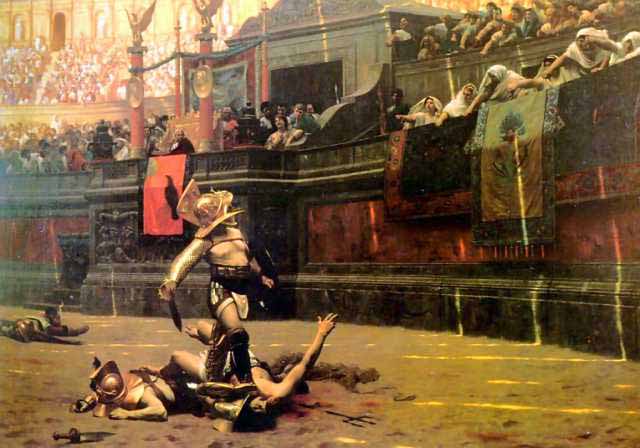
Romans cheer as the gladiator slaughters his victim
Perhaps a more humane means of entertainment was derived from the sport of chariot racing. Gathering at a racetrack, spectators would cheer on four teams: the Reds, Blues, Greens, and Whites; all of whom sported a lightweight chariot, four horses and a single charioteer. The winner was the first to complete seven laps around an elongated circular track-a distance of nearly four miles, and received a crown as well as a pouch of gold for their deeds. In one day, it was possible for an arena to host 24 races.
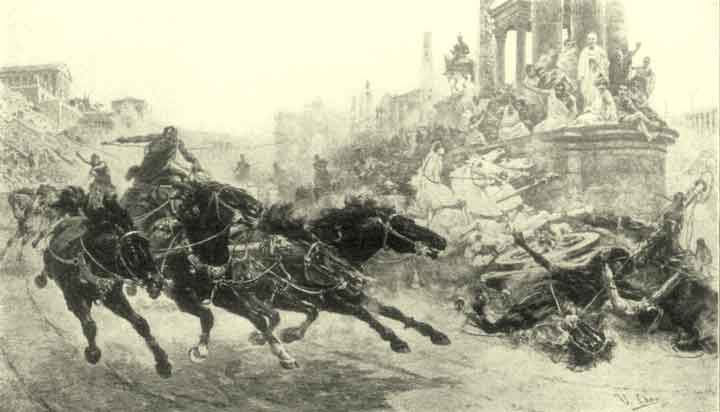
A scene from lively chariot race
TECHNOLOGY
The greatest technological feat of the ancient Romans was their production of roads throughout their empire. Originally conceived as a means of quickly and efficiently transporting the Roman military from one point to another, these highways created a direct route to their given destinations; even passing through hills and rivers if necessary. Realizing their convenient nature, Romans set out to create a network of these roads, eventually spanning 53,000 miles. As with all Roman structures, such craftsmanship was made to withstand the test of time, with the Via Appia, the first Roman road built in 312 B.C., still intact today. Construction of roads by slave laborers began with digging a 3 foot ditch. After being filled with sand, small stones, gravel, and concrete, paving stones were set in place, with marker stones incorporated to note a traveler’s distance.

One of the remaining Roman roads
ARTS AND ARCHITECTURE
The brilliant structures left as a legacy of the Roman Empire were mainly facilitated by their use of the arch and concrete. Arches, which evenly distributed the weight of a presented load were implemented in the design of bridges, amphitheaters such as the great Colossem, and aqueducts; one or two tiered structures which transported fresh water from a high to a low point. The discovery of concrete's fortitude created additional means of concocting unique structures. As a mixture of volcanic ash, lime, and water concrete was used to make the famed Pantheon’s domed ceiling, the largest in existence at this time. The Romans looked at the Pantheon as a means of worshiping their gods, with the domed ceiling representing the heavens, and its circular opening the sun.



The Pantheon Aqueducts The Colossem
These creations were filed and adorned with artistic elements, something that was of significant importance within Roman culture. Mosaics, or images created with cut pieces of colored tile, provided the blank canvas of walls and floors, with more ornate scenes. A technique known as fresco was also implemented on walls, which involved painting wet plaster. Statues were featured throughout homes, public facilities, and places of worship. Not only pleasing to the eye, they provided the reigning emperor with a means of projecting his image to the masses. Friezes were also a form of artistic expression through stone work, with scenes of Roman daily life carved into the sides of public buildings.
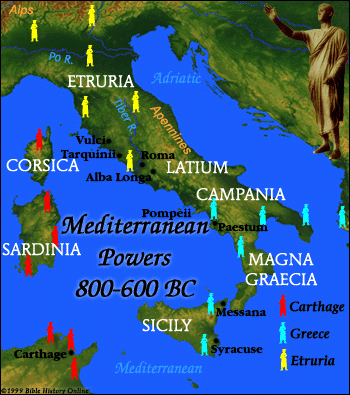
Map of Ancient Rome
CONCLUSION
While deriving most of their cultural background from their Greek predecessors, the Romans were successful in producing one of the first uniquely sophisticated civilizations. Their grandeur is evident in elements of their culture which are incorporated into our own modern day society. Ranging from government practices to architecture and language, the Romans may have fallen, but their ideals live on through us today.
WORKS CITED
- "Ancient Roman Education". Buzzle.com. Accessed: May 1st, 2009. Last updated: 2008. http://www.buzzle.com/articles/ancient-roman-education.html
- "Ancient Rome." Wikipedia, The Free Encyclopedia. 29 Apr 2009, 11:08 UTC. 3 May 2009 <http://en.wikipedia.org/w/index.php?title=Ancient_Rome&oldid=286828728>.
- Giovanni Milani-Santarpia “Ancient Roman Education.” Antiquities Of Rome. 2 May 2, 2009 <http://www.mariamilani.com/ancient_rome/ancient_roman_education.htm>
- Dickinson, Rachel. Tools of the Ancient Romans. White River Junction, VT: Nomad Press, 2006
- Connolly, Peter. Ancient Rome. Oxford: Oxford University Press, 2001
- Corbishley, Mike. The Roman World. New York, N.Y., Warwick Press, 1986
- Simpson, Judith. Ancient Rome. Sydney, Australia, Weldon Owen Pty Limited
Comments (0)
You don't have permission to comment on this page.